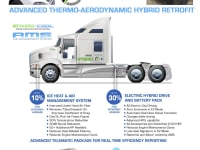Building on the Heavy Duty Aftermarket Super Truck project and the patented Air Management System that delivers up to 10% fuel savings, 50% reduced under-hood heat and restores 65+ horsepower from electrifying the cooling system – comes a new revolutionary solution for the transportation industry.
This second phase of development is a streamlined Charge-While-You-Drive-Hybrid upgrade that delivers an estimated 40%+ fuel savings, redundant hybrid-electric propulsion, easier operation and training, and a smart telematics package monitoring power, fuel and driver input with live reporting to fleets on detailed efficiency.
Electrifying all vehicle accessories such as the cooling system, AC condenser, water pump, and HVAC, an estimated 100HP+ can be restored to the internal combustion engine. Zero emission low-speed/idling and more efficient engine operation from only running at optimal power on the highway will dramatically decrease the CO2/NOX produced. Reduced ICE operation lowers emissions through lower fuel use, and lowers cost of ownership through less maintenance, downtime, and part replacements. Redundant propulsion removes the need to pay for tows. The fuel savings will pay for itself in 3 years, allowing fleets with older trucks to use trucks longer. It will increase trade-in value and can be transferred to new trucks.
This retrofittable system will charge while driving at highway speeds. The unique design charges the battery with engine RPMs while driving. Over-the-road vocations will increase MPG and range through automatic switching from the engine to motor and back, using less fuel during standard routes.
The advanced cooling system not only benefits the ICE by improving airflow and cooling, it significantly adds value to hybrid and electric vehicles by reducing their coefficient of drag and increasing ram air to cool batteries and motors. It allows for down-speeding the ICE or spec’ing a lower HP engine that consumes less power in an HEV, due to increased available horsepower from electrified accessories. This results in significant weight reduction estimated at $3/lb/load. With increased MPG, a smaller fuel tank can be used further decreasing weight.
The dual systems optimize each other converting a fleet’s aging assets into “better-than-new” Super Trucks and will solve the current Glider-Kit issue.
Benefits:
• Zero-emissions in EV mode
• Recharges while driving
• 40%+ estimated fuel savings from EV mode / improved engine environment
• Increase of 100+ available HP
• More efficient ICE operation/combustion (lower CO2/NOX)
• Down-sped Engine / light-weighting
• 50% under-hood temperature reduction
• 50dB sound reduction
• Reduced coefficient of drag
• Ports/DoTs with low-speed vehicles = Zero-Fuel = Zero-Emissions
• Congestion accounts for $63.4 billion in lost costs, low-speed EV operation reduces this
• Military benefits: Stealth-Electric, low-heat signature, low-acoustics, and low-fuel consumption (hostile environments can cost taxpayers $600/gal of fuel for transport/security)
This is the answer to the world’s transportation challenges in the interim while full long-range EVs are developed. When the industry is ready for long-range EVs, the Heavy Duty Aftermarket Super Truck will continue to be a useful upgrade to EVs with significantly fewer maintenance issues, especially with ICE hybrids.
Like this entry?
-
About the Entrant
- Name:Joshua Medling
- Type of entry:teamTeam members:George Sturmon, Mark O'Hare, Joshua Medling, Susan Schmidt, Glenn Harris, Edward Murray
- Patent status:none





